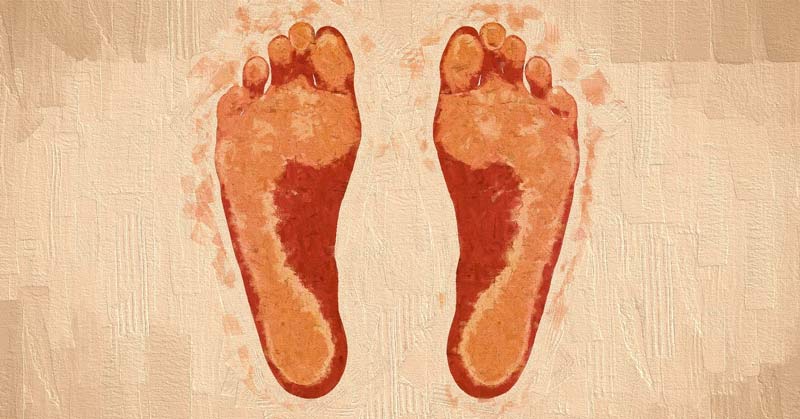
By Carl Valle
If you follow the latest innovations in sports performance, you have seen the use of force plates moving from the research world to professional teams and colleges. Some private facilities tout them as ways to decode what causes injuries and what holds the key to improved performance. The use of pressure mapping to solve complex foot and lower extremity injuries among elite soccer clubs is even more intriguing. I have used specialists who leverage the technology to add more insight to their craft since 2001, and seen how the research and clinical experience can really make a difference. On the other hand, a lot of bogus claims keep us stuck in the mud as a profession.
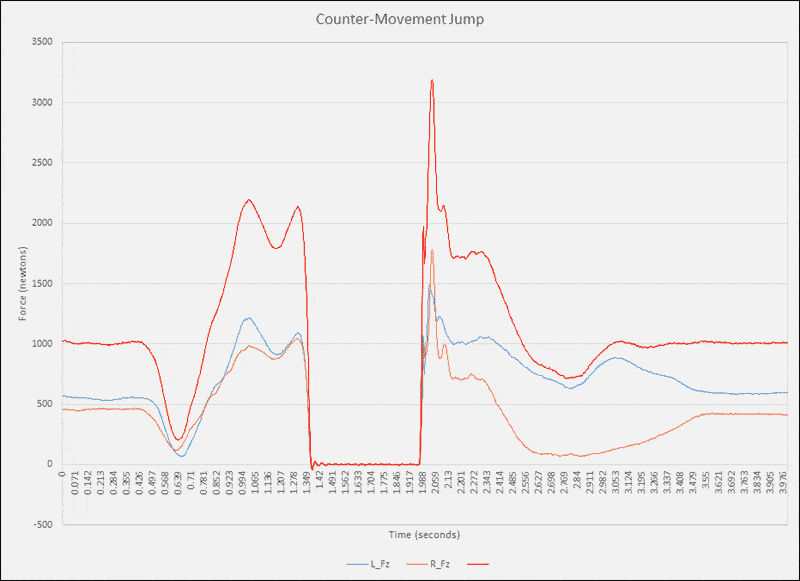
Figure 1. The force/time curve of a dual force plate synchronized to capture right and left leg simultaneously. Some systems being touted use one force plate and average the forces, a major weakness.
Several times a week I muster the same long email responses to many myths of using a force plate with strength coaches, and the problem is trending now. Several providers of force plate systems and services are growing in popularity—Sparta Science, P3, Andy Franklin Miller, and more. Accelerometer-based products like Bar Sensei and Push have made efforts (some successful, some still needing evolution) to capture force production in the weight room. The Australian system GymAware provided a solid proxy to force output for years, and coaches love getting instant feedback with elite athletes.
Everyone can learn from the science of Newtonian physics to help their athletes. Share on XFinally, we have the surge in pressure mapping tools that improve cleat or boot fit, as well as adding another perspective to gait analysis. Tekscan, Novel, and Moticon systems are solving problems for sports medicine professionals as gait analysis is growing and becoming more practical. Coaches and sports medicine professionals are realizing that instead of using research to validate general concepts, it’s better to research their own athletes with the same instruments they are reading about in the literature. This is a great idea on paper, but when the rubber hits the road, it can be a very dangerous course.
This article will straighten out what is going on with force-time curves in sports motion, specifically with the common approaches of using force plates for jumping and pressure mapping for screening foot strike. Not everyone will be investing into $20K systems, but everyone can learn from the science of Newtonian physics to help their athletes.
Beware of Geeks and Greeks Bearing Gifts
Several professional teams have asked me what the best force plates are. Others wonder if pressure mapping will be the next big thing and worth the investment. My response has and will always be the same: Never purchase anything unless you can interpret the information the instruments measure.
A force plate is a simple tool that records the body mass and muscular output changes into the platform surface over time.
That is all. Interpretation should not be more than how forces are created and transferred in that sporting movement. Extending out to diagnose specific injury or fatigue risks is getting into crystal ball country, not predictive analytics. A vertical jump is a useful action to peer into the nervous system, but biomechanically how jumping with two legs up translates to sprinting on a grass field or changing direction in basketball is limited. The use of force plates in professional baseball perplexes me. It may be great to see how leg power is modulating, but expecting it to help keep pitchers healthy is a pipe dream.
My concern is that professional sports teams are extending the value and significance of the force-time curves beyond what the science is telling us. This is not just voodoo or wishful thinking;, it’s closer to snake oil. Jumping vertically has some value to coaches and even sports medicine professionals, but to distill injury risk to a vertical jump profile is analogous to diagnosing disease based only on a stethoscope.
If force plates could solve our injury problems, it seems that many teams are either not using them or failing to take advantage of the data. Injuries are still piling up. Remember that the technology is older than the players currently in professional sport, so if it were a Holy Grail, we would have found it when everyone was rocking cassette players and watching The A-Team.
Moving to another solution that captures force-time curves, the use of pressure mapping devices is going to get more popular now that the technology is more user-friendly. Pressure mapping is basically using an insole of sensors to see all the changes in vertical forces that interact with the foot. While not a force plate inside a shoe, the data does have validity to see relative force. But the absolute forces are not perfect.
The technology is designed to measure how each foot strike distributes its respective forces through the ground at a high sampling rate—how many times the device is measuring per second. Some devices collect data like a high-speed camera. Amazing stuff, but like any tool it requires a lot of education to do more than show cute charts to sportswriters looking for a good story on “data” or “science.”
Looking at the data, medical professionals can solve for abnormal issues and make better decisions on footwear, orthotic interventions, therapy, and rest. All this technology is currently being used in research. The objective measurements can be used to help professional teams get better and define problems with more resolution. The promise of reducing injuries and improving performance sounds great on paper, but let the buyer beware. Many hardware systems eager to get sales are matching up with thought leaders to sell more of their products. You need to know who is providing genuine education and who is just marketing dubious science.
What Force Plates Actually Measure
A medical-grade force plate and the right software can dramatically reveal important changes to athlete function if used correctly. Three variables are clearly needed. Any break in the chain will make a force plate a very expensive toy for organizations, who will realize it is collecting dust when a new performance staff brings in the flavor of the month as the coaching regime changes.
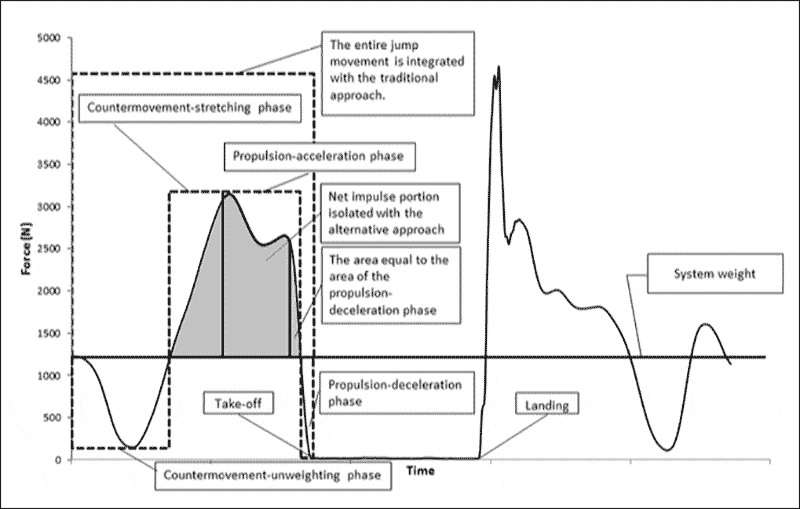
Figure 2. Satoshi Mizuguchi’s thesis on net impulse illustrates the time course of how power creates a jumping action. Reducing a jump into 2-3 bar charts is like summarizing the complexities of an EKG as only beats per minute.
Force plates are simply a few square meters of measuring ground reaction forces. They are mainly useful for vertical jumping and sometimes sampling a running step if integrated into a high-speed treadmill, but they are just one shade of the necessary colors in a pallet of data to create a complete picture. Remember that force plates can provide only the following:
The amount of force one can transfer into the ground over time.
This summary is basically the limit of direct information a device like a force plate can provide. Not to oversimplify, but force plates are not much different than weight scales sampling at fast speeds. Sure, calculations and sometimes estimations of other metrics like peak power, mean force, and other scores can be acquired when the time segments of the force-time curve are dissected, but some pundits are extrapolating a lot from one set of numbers. The body is a complicated orchestration of many movements and joints. One gross time curve isn’t the same as adding video or motion capture, so don’t “jump to conclusions” with a line plot on a flat screen in a gym.
Since most of the time people are extracting force profiles from bilateral vertical jumps using a single force plate, the information is junk when they don’t know if one limb is experiencing a poor neuromuscular performance. It’s truly amazing that many teams spend more than $50K on one force plate and repackaged software, when even a dual force plate system still needs video or motion capture to see the relationships of forces and motion of the body. Add EMG and now you are getting close to the whole picture. But keep in mind that research data is not team-friendly, so compromises are often made to do repeated measurements. Also, keep in mind that a research study may take a year or more to be studied and published—much different than the need for instant guidance.
The common and appropriate use of force plates is an attempt to gauge how power from training and subsequent rest interacts with individual athletes with primarily jump testing in the vertical plane. Bilateral jumping does indeed have some relationship to gross leg power in many sports, a prime variable to reducing injury and increasing performance. General leg power is not the golden ticket to running fast or reducing the dreaded ACL injury. It’s one part of the equation that is appropriate to test if properly sampled and interpreted. The problem now is it’s a wild west of unproven collection techniques, poorly executed analysis, and diluted reporting with cartoony graphs that would make the best sports scientists vomit. Yes, it’s that bad. But it’s like Santa Claus—everyone wants to believe because he brings toys every year.
What pressure mapping can provide for sports professionals
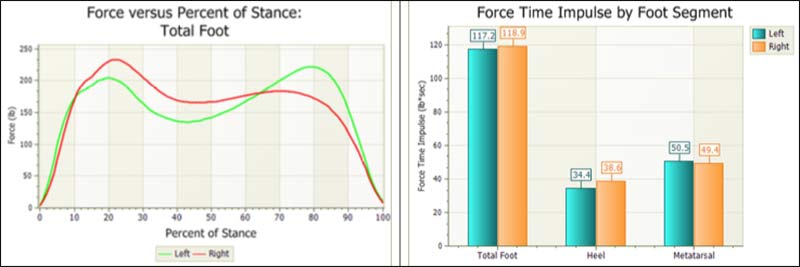
Figure 3. Peak forces are important for absolute reference, but the timing of the forces (left chart) shows it’s about how heel-to-toe pressures matter. Here right and left foot data are compared with the Tekscan software.
Pressure mapping can come in different forms. Sometimes it’s a walking mat or strip of carpet-like sensors, sometimes it’s a completely wireless thin insole. Think of an LCD screen with tiny pixels, with each pixel detecting various levels of pressure. The primary use of pressure mapping is ensuring the gait curve (force-time curve specific to locomotion) is in harmony with the anatomy of the subject it’s testing. Most of the time the data is used in podiatry, attempting to improve outcomes with such unfortunately common problems like diabetic foot ulcers. It’s growing with sports medicine as a testing service because research is discovering how the foot and lower extremity better interact with the ground and shoe better.
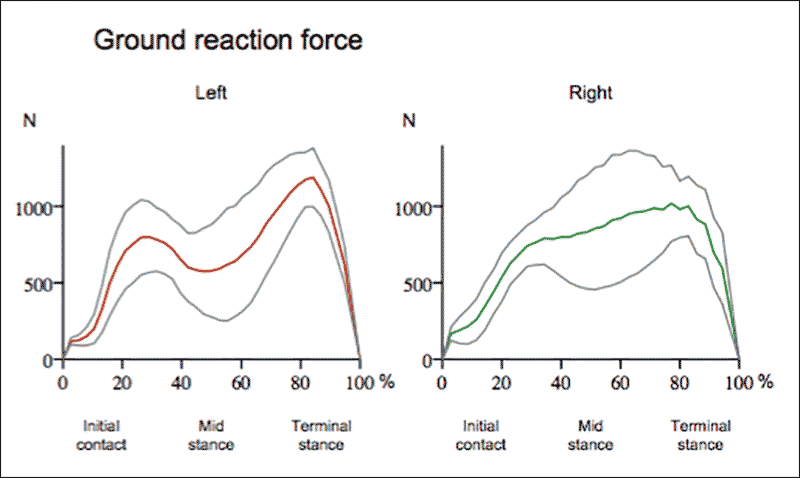
Figure 4. The force-time curves using the Moticon device and software are displayed above. The right-foot data is likely picking up a past knee injury—the athlete in question is actually me.
Not only does pressure mapping summarize force-time curves, but it can also capture the Center of Pressure (COP). While not a perfect definition, the COP is averaging the forces between the length and width of the foot every fraction of a second. The image below is a good illustration. Note the black line showing the summary of the distribution of forces through the sole of the foot, in addition to the peak forces with corresponding color codes.
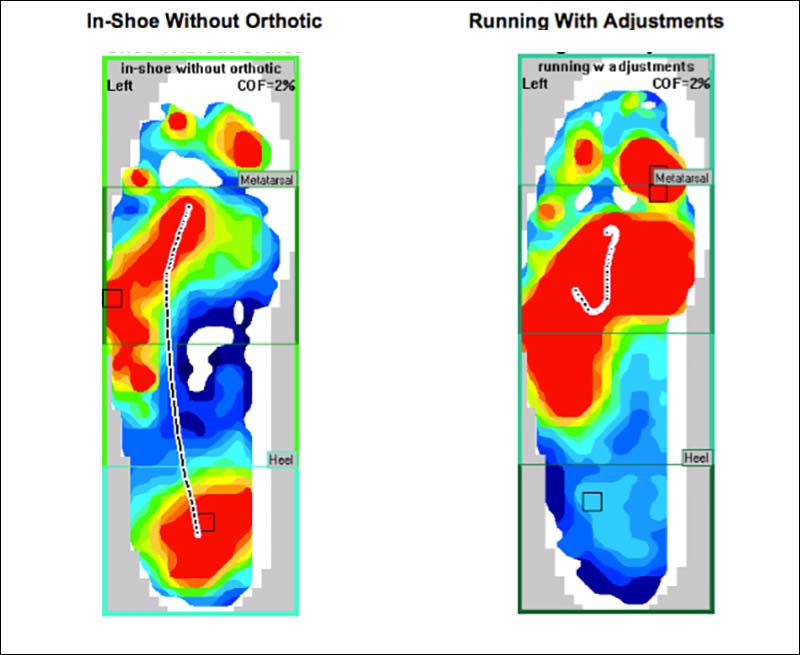
Figure 5. The COP or Center of Pressure is the black-and-white mark. You can see how orthotics changes pressures while running. Sometimes athletes are highly responsive, sometimes they are not and may find the intervention making the problem worse. Objective measurement helps find the right cleat or shoe fit.
The technology of pressure mapping is amazing and very useful, but clinical and research findings can evoke strong disagreement regarding the implications of the data. Ask a researcher what the findings of pressure mapping are. Usually, the response is “limited.” Ask a clinician, and the responses can range from “it depends” to “a staple in addressing problems.” The truth is that pressure mapping is medical imaging with motion. One needs the entire picture to make improvements, or the results may not surface.
My biggest criticism of research that analyzes forces and joint motion with pressure mapping is the poor study design construction. Getting 20 test subjects statistically summarized with crude foot evaluation approaches is antiquated, and not informative at all. Each foot is similar to a moving 3D fingerprint, rich in detail and individualism. While each subject may have similar data in the findings at the end of the investigation, how they get there is highly variable and often not included in the researcher’s conclusions. For example, some feet look anatomically different yet perform similarly, while others that look nearly the same may perform far differently. Taking the body’s most complicated joint system and summarizing it with rough labels such as “flat foot” or “high arch” is like using Starbucks sizing for a wedding dress fitting.
Orthotics has a polarizing reputation—sometimes getting too much credit, sometimes being attacked for doing “nothing” for athletes. Like prescription medication, orthotic treatments treat a problem that needs a lot of patient information to help. In the past, blood transfusions had a huge failure rate because many donors didn’t match blood type, so the body rejected even “healthy” blood. When athletes experience injuries, most of the problem is managing the training load and preparing the body properly. But some variables can’t be fixed with better strength training and training plans.
Orthotics are static devices and can address some problems, but they can’t fix everything. We have a myriad of coaches inspecting shoes and trying to match the right ones with their athletes. A shoe is an artificial addition to the foot, so those who want a natural orthotic-free fit often use a running shoe or cleat that unknowingly changes how the athlete interacts with the playing surface.
The goal of pressure mapping is to reduce aberrant forces that demonstrate direct pathological effects. Most of the impact of orthotics is minimal. But so is the difference in the modern NBA between winning and losing, and getting hurt and staying healthy. The fine line of what can injure an athlete pushing the body maximally can’t be summarized with conventional statistics, so modeling biological tissue and repair rates is what we need more of, not convenient statistical software packages that work for voter polls and crime figures of cities.
Pressure mapping is nothing more than an objective way to enhance what a good foot evaluation and gait analysis are already doing. It’s valuable to see direct problems with the foot, and indirect problems with the lower extremity and higher up. The pelvis and its function have a small influence as the body is interconnected, but it’s not as strong as many want to believe.
Many therapists feel threatened by podiatry as they don’t have the same education or even medical ability to influence what is happening below the knee. Like a psychologist who can’t prescribe medications like a psychiatrist, therapists should focus on what they are more qualified to handle and use a combined approach. Core training is an obsession, and if it were solving the world’s problems, we would have been saved from since the stability ball invasion of the late 1990s. Core training has been around since the dawn of time, and it’s not working as well as we want. So it’s about seeing every part of the kinetic chain that interacts with the ground.
Hardware, software, and marketing games

Figure 6. Good software should show all the data, not filter it. Having the data analyzed in an automated fashion is fine, provided the calculations reflect established standards of sport science research.
Most systems that elite teams and universities buy are usually bundled together, meaning if you purchase a piece of equipment you usually use the company’s software as well. As a user of sports technology for years, I know that what’s included can vary from amazing solutions to vomit from lazy software engineers who have no pride in their work. Many companies try to sell “added value” systems by tweaking existing software to make it appear more advanced or special. Usually, though, it’s nothing more than a logo swap and a few features.
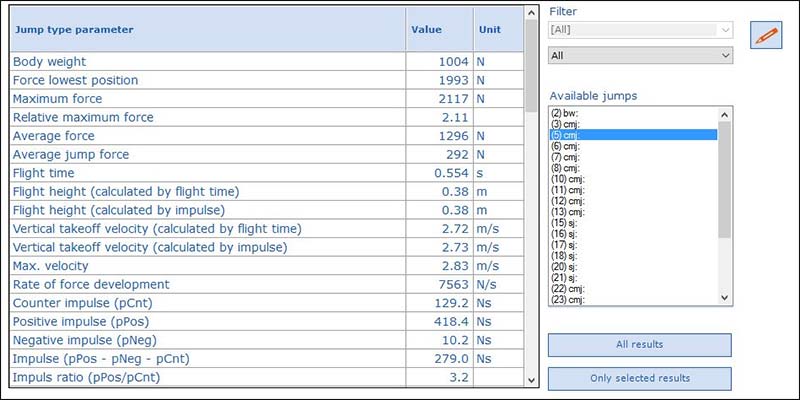
Figure 7. Calculations should be based on accepted sport science formulas, not proprietary or in-house metrics. Sometimes it’s fine to have new calculations, provided the math and its origin are explained.
WARNING: The biggest pitfall in sports performance technology is ignorance of what the hardware can do and how the software spits out information. Some companies are truly innovating and pushing faster than research as equipment and data are surging in availability, but anything proprietary is still likely to marketing hype. The best solution is to send the marketing claims to sport scientists who spend 100% of their time looking at the same data and see if any merit exists. Most of the time it’s like a new supplement—lots of promise but little actual effect or scientific proof.
A great solution is software that displays data clearly and doesn’t try to do too much. Coaches need transparency, not filtered glitter data. When one is estimating on estimations, calculations become random number generators. Coaches need to understand the difference between a direct measurement and a calculation. I roll my eyes when sales staffs use the magic word “algorithm,” thinking it’s a discovery rather than a formula that estimates what is happening with advanced mathematics.
Solutions with force plates and pressure mapping
Many professionals interested in buying instruments feel the pressure (pun intended) from management, peers, and athletic directors. Sometimes athletes will ask as well when social media and the YouTube world hype force plates or show Cristiano Ronaldo getting fitted for cleats. We are seeing elite athletes getting 3D printed orthotics now. The technology will soon be available everywhere, not just with pros. My concern is that people forgetare forgetting the simple and big perspective. I frankly hate listing or summarizing, but the two tools I’ve discussed mainly take care of three primary needs.
- Force plates are great for jumping and getting power profiles with a lot of granularity in force production. Contractile dynamics of the neuromuscular system can be dissected a bit, but the conclusions are very general, and specifics to other motions are limited.
- Pressure mapping is great for screening injury and performance in conjunction with gait analysis. Decisions based on foot function and the relationship up the kinetic chain can be deciphered with a holistic approach and other data feeds.
- Both pressure mapping and force plates can help athletes return to play by analyzing rehabilitation progress.
Both tools help athletes, but to create training programs in the weight room from a force plate is asinine. Using pressure mapping without a comprehensive clinical foot evaluation by a professional is also foolish. In summary, force plates help show how the strength program is doing and maybe how some fatigue is interacting. But the reality is it’s not to develop athletic performance, just likely lower body power and balance. Pressure mapping is designed to fine-tune foot/ankle function and footwear, not diagnose injury alone.
Solution 1: Performance changes and testing
Most coaches try to observe development with their athletes. Elite athletes have reached a high level of success in their sport, but are not finished products. Due to the constraints of travel and team game schedules, athletes compete underprepared because everyone allows it, including the players themselves. Let’s face it—most fans come to preseason training because they want to see some action. Nobody is going to pay big-ticket prices to see teams do small-sided games and half-court scrimmages. The goal of professional and college athletes is to ensure that biological, chronological, and training ages are equal. Instead of listing three bar charts from a vertical jump, it’s better to test multiple exercises and sport movements and just look at the force-time curve in detail.

Figure 8. Biomarkers have shown to be influenced by fatigue and thus correlating with explosive strength qualities. The image on the right is force plate data integrating with an athlete management system used by top teams in the NFL, NBA, MLB, and NHL.
Solution 2: Medical screening versus medical diagnostics
Modern medicine usually identifies structural damage to anatomical points of interest as a diagnosis, provided it is coupled with clinical findings that match the imaging. Medical imaging isn’t going away soon, but functional outcomes in foot mechanics are growing in value. What is confusing is the difference between modern athlete screening and medical diagnosis, when many methods overlap and are similar. Here is the core summary:
- Screening – Athlete risk can be appraised when the etiology of common non-contact injuries is compared to evidence-based practices. Screening is done before one is injured to identify risk factors that can increase the likelihood of neuromuscular faults to joint and soft tissue.
- Diagnosis – Pathomechanics in conjunction with athlete clinical findings can enhance the confidence in the mechanism or severity. The main purpose of using pressure mapping and force plates with injuries is to restore the athlete to baseline or construct an intervention and return to play program.
Pressure mapping and force plate analysis can help with injury screening and diagnosis, but the literature is exhausting and must be combed over. Currently, no software magically creates a diagnosis or screens injuries without expertise, but the calculations can be interpreted with mild education.
Solution 3: Jumping, throwing, and running analysis
Teams, academies, and colleges measure common movements in sport and try to see what motions and forces increase injury risk. As mentioned earlier, a lot of variation between athlete populations and genetics that may make up much of the data are not specific enough to explain everything. Very few marathon runners tear ACLs unless they step funny, very few athletes pull hamstrings jumping up, and very few pitchers tear Achilles tendons on the mound. In general, based on the rates, injury type, and population, the sports world is trying to do the following with force plates and pressure mapping:
- Create a sensible symmetry to increase the probability of performing well and reducing injury. As speeds and forces increase, so does injury risk. Some asymmetry is normal, but the body has only so many resources to manage forces that are not in harmony.
- Identify researched factors known to be etiological points of risk for injuries. Some cardinal variables to injuries are valid, and simple things like landing can be assessed with force plates in addition to video.
- Control and manage forces in combination with the athlete’s shoes or cleats to ensure comfort and appropriate levels of function. Ski boots and skates are much different than track spikes and football cleats, so one is trying to ensure that no factor is causing damage or increasing the indirect risk of injury.
Throwing athletes should use force plates to manage ground reaction responses by measuring their throws. Runners and sprinters can use treadmills or measure foot strike by sampling a few steps. Jumpers have perhaps the easiest and most direct option—simply testing their sporting style. Testing what people do isn’t rocket science and is not novel, but using jumping for every sport is too narrow and not valid for deducing specific risk or dissecting impairment.

Figure 9. Baseball force plates. Why not just measure the sport action directly, not just gross training exercises. Relationships to general training and sport specific action can be teased out with some investigation, but only testing jumps and not activities that are the problem is strange. Cutting, sprinting, and throwing should be looked at, not just vertical jumps.
Parting wisdom on measuring forces from the feet up
It can be nerve-racking when unfamiliar technology that holds a possible promise of improved sports performance appears. Don’t worry. Remember that jump testing, cutting, and running are all areas that coaches can help improve, and sports medicine professionals can screen and rehabilitate. Measurements help add more precision to what we see, and the goal of the technology is to assist professionals, not replace them.
Some amazing athletic feats happen because great talents do a lot of special things quickly and forcefully into the ground, and that data can be collected and reported instantly. Now and in the future it’s expected that the simple line plot of forces can be measured and improved when good technology meets great people, and education can pave the way.
Please share so others may benefit.
[mashshare]


Nice to see you wrote about force platforms. I think it’s an undeveloped field.
Unfortunately I find many assumptions in this article without explanation, which blur the real possibilities of a force platform and in some cases are just incorrect.
hello
thank you for this presentation
my question is :
haw can calculate net force from force platform fore example below by zebris force platform Germany
Right side force(N) = {
Right forefoot = {
Record: 15-11-2012 moada = {
Time, sec Value, N
0.28 23.2933
0.29 222.182
0.3 202.831
0.31 882.278
0.32 1005.19
0.33 1095.14
0.34 997.669
0.35 957.174
0.36 948.932
0.37 953.591
0.38 920.98
0.39 857.551
0.4 735.351
0.41 607.775
0.42 484.858
0.43 390.61
0.44 322.164
0.45 261.601
0.46 192.438
0.47 170.578
0.48 160.903
0.49 145.135
0.5 122.558
0.51 106.791
0.52 86.0059
0.53 60.2042
0.54 35.4774
0.55 12.5425
0.56 0
0.57 0
hi
I red the last comment and wish to find any respons, but there is not
how could calculate the net force as the question above ?
[email protected]
[email protected]